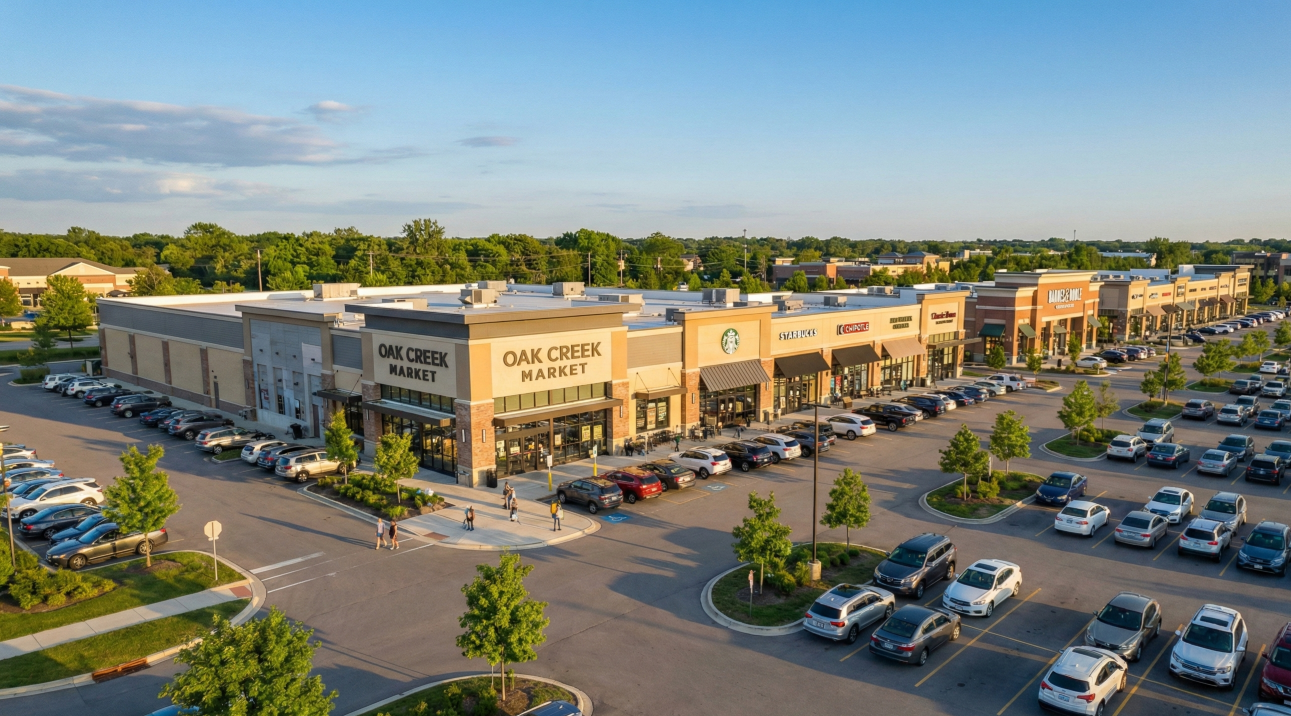From Macro Noise to Micro Insight: How Retail Decision-Making Is Evolving

As 2025 winds down, retail decision-makers are navigating a landscape that feels both familiar and unpredictable.
Economic signals remain mixed—growth in some sectors, caution in others. Consumer confidence continues to fluctuate month to month. Even seasoned operators admit that the usual metrics feel less reliable than they once did.
Yet step into almost any market, and you’ll find a more complex story unfolding on the ground. Grocery-anchored centers continue to outperform. Select suburban corridors are adding new tenants. And in certain secondary metros, population growth and spending power are still rising faster than the national average.
The contradiction isn’t new, but it’s growing sharper. National data can reveal the mood of the market, but not its momentum. What looks like a slowdown in aggregate often hides dozens of submarkets where leasing is steady and retail pipelines remain active. According to CBRE’s Q2 2025 U.S. Retail Figures, half of major metro markets still posted positive absorption, with the strongest gains concentrated in mid-sized Sun Belt metros like Nashville, Tampa, and Charlotte.
The truth is that retail has become deeply local—and averages increasingly obscure more than they explain.
That disconnect is reshaping how retailers, landlords, and city leaders make decisions.
Rather than waiting for clearer macro signals, many are turning to micro-market data—mobility analytics, trade area spending, and real-time behavioral patterns—to understand where opportunity still exists. The shift isn’t about forecasting the economy; it’s about validating the ground truth. And in an era defined by volatility, that precision may prove to be the most durable advantage of all.
Why Macro Data Falls Short
National indicators still set the mood of the market—but they rarely explain its mechanics.
Retail sales, vacancy rates, and consumer sentiment indexes are helpful for gauging direction, yet they compress thousands of unique markets into a single number. The problem is that retail no longer behaves like one market.
Averages blur the difference between a corridor where leasing has stalled and another, five miles away, where demand for outparcels still outpaces supply. JLL’s U.S. Retail Market Update (Q3 2025) found that while overall leasing velocity flattened, prime suburban corridors continued to report record-high occupancy and rent growth—a reminder that national trends can mask hyperlocal momentum.
That compression can lead to hesitation at the very moment precision is needed most. Developers postpone projects because “the market looks soft.” Retailers slow expansion despite evidence that specific trade areas are still growing. Landlords hold off on repositioning even when tenant turnover data shows opportunity. The disconnect isn’t about optimism or pessimism—it’s about scale. The national view describes conditions; the local view reveals decisions.
Macro data will always have a role—it provides valuable context for risk and capital flows. But the real insight—the kind that shapes deals, site plans, and tenant mixes—lives in smaller geographies and faster feedback loops. Deloitte’s 2025 U.S. Retail Industry Outlook points out that “macro volatility has increased the importance of localized analytics for forecasting and investment.” When micro signals diverge from the national storyline, they often point to the next pockets of growth long before quarterly reports catch up.
The Rise of Micro Insight
What’s changed isn’t just access to data—it’s the resolution of that data. Decision-makers can now see, almost in real time, how people move through trade areas, where they cross-shop, and how spending habits shift between corridors. These micro signals are transforming how retailers, landlords, and cities assess risk and opportunity.
Placer.ai’s 2025 Retail Foot Traffic Review found up to a 30-point performance gap between top and bottom submarkets within the same metro—proof that local behavior now drives the retail story more than national averages. That granular visibility is reshaping portfolio planning, helping teams allocate capital with greater precision.
Retailers are already operating this way. Leading brands are increasingly using mobility and behavioral analytics to guide site selection, market entry, and tenant mix decisions. Expansion strategies are being built on neighborhood-level modeling—drive-time analysis, co-tenancy clustering, and localized spending behavior—replacing intuition with evidence.
For landlords and municipalities, the same principle applies. Understanding micro-market dynamics—commuter flows, daytime population, and spending leakage—can determine whether a project fills quickly or lingers vacant. Coldwell Banker Commercial’s Mid-2025 Retail CRE Playbook cites submarket-level demographic alignment as the top predictor of leasing success.
Micro insight doesn’t eliminate uncertainty, but it does something better: it makes uncertainty measurable. And in a fragmented market, that clarity can be the difference between holding steady and finding the next growth path.
Case in Point: Micro Markets That Defy the Trend
Across the country, a patchwork of retail stories is unfolding—some cautious, others quietly strong.
In a year defined by uncertainty, what stands out isn’t broad momentum but selective resilience. The markets that continue to perform share one common trait: alignment between data and local fundamentals.
Suburban corridors with staying power.
Secondary and exurban markets—once viewed as late-cycle bets—are now driving a disproportionate share of leasing activity. These are areas where population growth, household income, and commuter patterns converge to support consistent daily-needs retail. Grocery-anchored and neighborhood centers remain especially resilient, capturing steady demand from service-oriented and essential retailers even as broader retail metrics fluctuate.
Repositioned centers that reflect new habits.
Properties that pair data-driven tenant mix strategies with targeted physical improvements continue to outperform. The strongest repositioning efforts have shifted away from discretionary categories toward high-frequency uses—fitness, wellness, food, and services that bring customers back multiple times a week. The result is stronger occupancy, longer dwell times, and more predictable NOI growth.
Retailers reading the ground truth.
Brands expanding in 2025 share a disciplined approach: they’re not chasing volume—they’re validating markets. Expansion pipelines are increasingly focused on select metros and suburban nodes where mobility data, demographic migration, and local spending indicators all point in the same direction. It’s not contrarianism—it’s calibration. In a fragmented market, this measured, data-first approach is what distinguishes progress from speculation.
Each of these examples underscores the same point:
local performance often moves out of sync with national narratives. In a market this fragmented, success depends less on guessing when conditions will stabilize and more on identifying where they already have.
From Macro to Micro: A Framework for Smarter Decisions
The move from macro awareness to micro precision doesn’t require a new toolset—it requires a new mindset.
Retail success in 2026 will hinge on how well organizations integrate broad perspective with local validation. A simple, repeatable framework helps ensure that no decision rests on one data point alone.
1. Start with macro awareness.
Track national and regional indicators to understand capital sentiment and baseline risk. They set the guardrails for decision-making.
2. Validate with micro metrics.
Layer in localized data—drive-time population, traffic patterns, spending leakage—to identify true demand pockets within markets that look flat at the top line.
3. Add behavioral insight.
Foot-traffic analytics, cross-shopping data, and visit frequency can distinguish between one-time visitors and habitual customers, shaping both tenant and site selection.
4. Translate data into strategy.
Combine analytics with on-the-ground intelligence—broker input, community feedback, infrastructure plans—to test alignment between numbers and reality.
5. Monitor continuously.
Markets shift fast. Establish cadence reviews for portfolio performance, corridor health, and emerging opportunities.
AlphaMap’s 2025 CRE Data Survey found that organizations combining national trend data with local mobility and spending analytics improved site-level ROI projections by 25% compared with those relying solely on demographics. The advantage lies in staying ahead of change, not reacting to it.
The Payoff: Precision, Not Prediction
In uncertain times, it’s tempting to wait for the numbers to stabilize. But retail rarely moves in unison, and opportunities rarely wait.
The advantage now belongs to those who can separate the noise from the signal—to see not just where the market is, but where it’s quietly working.
Micro insight doesn’t replace the macro view; it refines it. It allows teams to allocate capital, choose tenants, and plan expansions with a level of confidence that broad trends can’t provide.
The most successful strategies ahead will belong to those reading the market with precision, not prediction—those who trust verified local data over speculative sentiment.
Closing Thought
Retail has always been cyclical, but it’s also adaptive.
Today’s volatility isn’t just a test of patience—it’s a test of precision. The strongest decisions in the coming year will come from those who look closer, measure faster, and trust the details beneath the averages. Because in a landscape this uneven, the next wave of growth won’t be found in the headline data—it’ll be discovered one corridor, one trade area, and one insight at a time.
Explore how precision data is reshaping site selection and market strategy in CRE. Request a Strategy Consultation
Ready to Elevate Your Strategy?
Schedule a consultation today to discuss your project and see how we can help you achieve your goals.
Stay Updated with CRE 360
Get the latest insights and updates from CRE 360 in your inbox.




